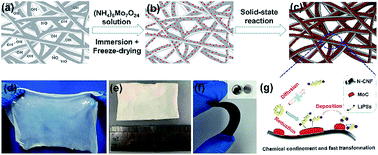Necklace-like MoC sulfiphilic sites embedded in interconnected carbon networks for Li–S batteries with high sulfur loading†
Abstract
The shuttling of dissolved polysulfide intermediates and their sluggish reaction kinetics largely reduce the cycle life and sulfur utilization of lithium–sulfur (Li–S) batteries. In this study, low-cost bacterial cellulose was used as the precursor for interconnected carbon networks and a supporting framework for impregnated molybdate ions. After freeze-drying and solid-state thermal reactions, necklace-like molybdenum carbide embedded in interconnected N-doped carbon nanofibers (MoC@N-CNF) was obtained to be used as a high sulfur loading host. On the one hand, the interconnected conductive carbon network enables fast electron and ion transport, and on the other hand, the embedded sulfiphilic MoC efficiently immobilizes polysulfides and catalytically promotes their redox conversion. Therefore, the as-prepared electrode coupled with the lithium polysulfide catholyte exhibits good cycling stability with a low capacity decay of 0.084% per cycle at 1C for 350 cycles and a high rate capability of 799 mA h g−1 at 2C. Moreover, a high areal capacity of 12.3 mA h cm−2 with an areal sulfur loading of 10 mg cm−2 at 0.1C is also achieved.



 Please wait while we load your content...
Please wait while we load your content...